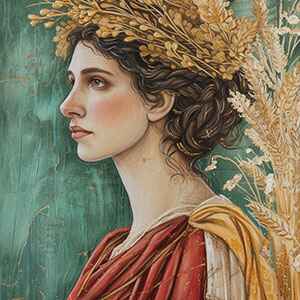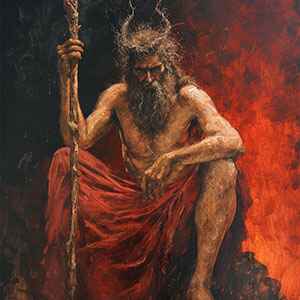Persephone
In Greek mythology, Persephone is the goddess of the underworld and the daughter of Demeter, the goddess of agriculture. Persephone's story is intricately connected with the changing seasons, and she is a central figure in the Eleusinian Mysteries.

Abduction by Hades: The most well-known myth involving Persephone is her abduction by Hades, the god of the underworld. Hades, enamoured by Persephone's beauty, abducted her to be his wife. While she was picking flowers in a meadow, the earth split open, and Hades emerged to take her to the underworld.
Mother-Daughter Reunion: Demeter, grief-stricken by the disappearance of her daughter, wandered the earth in search of Persephone. During her search, the earth became barren, and crops failed. Zeus intervened and arranged for Persephone's return to the surface but with a condition.
Seasonal Cycle: Persephone's time in the underworld became associated with winter, and her return to the surface marked the arrival of spring. This cyclical journey symbolizes the changing seasons and the cycle of life, death, and rebirth.
Queen of the Underworld: Despite the circumstances of her marriage, Persephone became the queen of the underworld. As such, she played a significant role in the realm of the dead.
Eleusinian Mysteries: The Eleusinian Mysteries were secret religious rituals dedicated to Demeter and Persephone, celebrating the cycle of life and agricultural fertility. These mysteries were among the most revered and secretive in ancient Greece.
Attributes and Symbols: Persephone is often depicted as a young woman, sometimes with a pomegranate, which symbolizes both the abundance of the earth and her connection to the underworld. The pomegranate seeds consumed by Persephone in the underworld bound her to Hades for a portion of each year.
Associations with Fertility: In her role as the daughter of Demeter, Persephone is associated with fertility and the growth of crops. Her return to the surface brings about the blossoming of plants and the rejuvenation of the earth.
Mythological Encounters: Persephone is involved in various myths and encounters, including her interactions with other gods and goddesses, such as Hermes, who acted as a messenger during her abduction.
Elysium and Asphodel: In the underworld, Persephone presides over different regions, including Elysium (a paradise for the virtuous) and the Asphodel Meadows (a neutral or less distinguished afterlife).
Cultural and Literary References: Persephone's story has inspired numerous works of art, literature, and cultural expressions throughout history. Her myth is explored in various ancient Greek texts, including the "Homeric Hymn to Demeter."
Roman Equivalent: In Roman mythology, Persephone is identified with Proserpina.
Persephone's myth captures the duality of life and death, the changing seasons, and the interconnectedness of the natural world. Her story is not only a reflection of ancient Greek beliefs but also a timeless and enduring narrative that continues to resonate in cultural and artistic contexts.
Immediate Family
Quick Facts
- Abducted by Hades and became the queen of the underworld.
- Her story is intricately connected with the changing seasons.
- Key figure in the Eleusinian Mysteries.
- Associated with fertility and the growth of crops.
- Her myth inspired various cultural and literary works.
- Identified with Proserpina in Roman mythology.
Further Reading
Art &
Architecture
Ancient Greek art and architecture, with its harmonious proportions and timeless elegance, continue to inspire awe and admiration millennia later.
Discover
Greek Mythology & Mythical Characters
Greek mythology, a rich tapestry of gods, heroes, and mythical creatures, captivates the imagination with its tales of love, betrayal, and epic adventures that delve into the depths of the human psyche.
Discover
Ancient Greek History
Ancient Greek history, marked by remarkable achievements in democracy, philosophy, and warfare, shaped the foundation of Western civilization, leaving an indelible legacy of innovation and cultural influence that continues to resonate to this day.
Discover
Ancient Greek Olympics
The ancient Greek Olympics, held in Olympia every four years, celebrated athleticism, unity, and cultural pride, serving as a testament to the enduring spirit of competition and excellence that transcends time and borders.
Discover
Ancient Greek Wars
Ancient Greek wars, such as the Persian Wars and the Peloponnesian War, were pivotal conflicts that shaped the course of history, highlighting the struggle for power, independence, and the clash of civilizations in the ancient Mediterranean world.
Discover
Ancient Greek Culture and Society
Ancient Greek culture and society, characterized by its emphasis on art, philosophy, and civic engagement, fostered a vibrant intellectual and social landscape where innovation flourished, democracy thrived, and the pursuit of knowledge and excellence was celebrated as fundamental values of civilized life.
Discover

